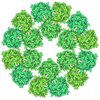+ データを開く
データを開く
- 基本情報
基本情報
| 登録情報 | データベース: PDB / ID: 8y9b | |||||||||
|---|---|---|---|---|---|---|---|---|---|---|
| タイトル | TcdB1 in complex with mini-binder | |||||||||
 要素 要素 |
| |||||||||
 キーワード キーワード | TOXIN/DE NOVO PROTEIN / Mini-binder against C.difficle infection / TOXIN-DE NOVO PROTEIN complex | |||||||||
| 機能・相同性 |  機能・相同性情報 機能・相同性情報symbiont-mediated perturbation of host actin cytoskeleton via filamentous actin depolymerization / glucosyltransferase activity / 転移酵素; グリコシル基を移すもの; 六炭糖残基を移すもの / host cell cytosol / cysteine-type peptidase activity / host cell endosome membrane / toxin activity / 加水分解酵素; プロテアーゼ; ペプチド結合加水分解酵素; システインプロテアーゼ / lipid binding / host cell plasma membrane ...symbiont-mediated perturbation of host actin cytoskeleton via filamentous actin depolymerization / glucosyltransferase activity / 転移酵素; グリコシル基を移すもの; 六炭糖残基を移すもの / host cell cytosol / cysteine-type peptidase activity / host cell endosome membrane / toxin activity / 加水分解酵素; プロテアーゼ; ペプチド結合加水分解酵素; システインプロテアーゼ / lipid binding / host cell plasma membrane / proteolysis / extracellular region / metal ion binding / membrane 類似検索 - 分子機能 | |||||||||
| 生物種 |  Clostridioides difficile (バクテリア) Clostridioides difficile (バクテリア)synthetic construct (人工物) | |||||||||
| 手法 | 電子顕微鏡法 / 単粒子再構成法 / クライオ電子顕微鏡法 / 解像度: 3.2 Å | |||||||||
 データ登録者 データ登録者 | Lv, X.C. / Lu, P.L. | |||||||||
| 資金援助 |  中国, 2件 中国, 2件
| |||||||||
 引用 引用 |  ジャーナル: Nat Commun / 年: 2024 ジャーナル: Nat Commun / 年: 2024タイトル: De novo design of mini-protein binders broadly neutralizing Clostridioides difficile toxin B variants. 著者: Xinchen Lv / Yuanyuan Zhang / Ke Sun / Qi Yang / Jianhua Luo / Liang Tao / Peilong Lu /  要旨: Clostridioides difficile toxin B (TcdB) is the key virulence factor accounting for C. difficile infection-associated symptoms. Effectively neutralizing different TcdB variants with a universal ...Clostridioides difficile toxin B (TcdB) is the key virulence factor accounting for C. difficile infection-associated symptoms. Effectively neutralizing different TcdB variants with a universal solution poses a significant challenge. Here we present the de novo design and characterization of pan-specific mini-protein binders against major TcdB subtypes. Our design successfully binds to the first receptor binding interface (RBI-1) of the varied TcdB subtypes, exhibiting affinities ranging from 20 pM to 10 nM. The cryo-electron microscopy (cryo-EM) structures of the mini protein binder in complex with TcdB1 and TcdB4 are consistent with the computational design models. The engineered and evolved variants of the mini-protein binder and chondroitin sulfate proteoglycan 4 (CSPG4), another natural receptor that binds to the second RBI (RBI-2) of TcdB, better neutralize major TcdB variants both in cells and in vivo, as demonstrated by the colon-loop assay using female mice. Our findings provide valuable starting points for the development of therapeutics targeting C. difficile infections (CDI). | |||||||||
| 履歴 |
|
- 構造の表示
構造の表示
| 構造ビューア | 分子:  Molmil Molmil Jmol/JSmol Jmol/JSmol |
|---|
- ダウンロードとリンク
ダウンロードとリンク
- ダウンロード
ダウンロード
| PDBx/mmCIF形式 |  8y9b.cif.gz 8y9b.cif.gz | 319.2 KB | 表示 |  PDBx/mmCIF形式 PDBx/mmCIF形式 |
|---|---|---|---|---|
| PDB形式 |  pdb8y9b.ent.gz pdb8y9b.ent.gz | 244.6 KB | 表示 |  PDB形式 PDB形式 |
| PDBx/mmJSON形式 |  8y9b.json.gz 8y9b.json.gz | ツリー表示 |  PDBx/mmJSON形式 PDBx/mmJSON形式 | |
| その他 |  その他のダウンロード その他のダウンロード |
-検証レポート
| 文書・要旨 |  8y9b_validation.pdf.gz 8y9b_validation.pdf.gz | 1.2 MB | 表示 |  wwPDB検証レポート wwPDB検証レポート |
|---|---|---|---|---|
| 文書・詳細版 |  8y9b_full_validation.pdf.gz 8y9b_full_validation.pdf.gz | 1.2 MB | 表示 | |
| XML形式データ |  8y9b_validation.xml.gz 8y9b_validation.xml.gz | 57 KB | 表示 | |
| CIF形式データ |  8y9b_validation.cif.gz 8y9b_validation.cif.gz | 86.3 KB | 表示 | |
| アーカイブディレクトリ |  https://data.pdbj.org/pub/pdb/validation_reports/y9/8y9b https://data.pdbj.org/pub/pdb/validation_reports/y9/8y9b ftp://data.pdbj.org/pub/pdb/validation_reports/y9/8y9b ftp://data.pdbj.org/pub/pdb/validation_reports/y9/8y9b | HTTPS FTP |
-関連構造データ
| 関連構造データ |  39072MC  8y9cC M: このデータのモデリングに利用したマップデータ C: 同じ文献を引用 ( |
|---|---|
| 類似構造データ | 類似検索 - 機能・相同性  F&H 検索 F&H 検索 |
- リンク
リンク
- 集合体
集合体
| 登録構造単位 | 
|
|---|---|
| 1 |
|
- 要素
要素
| #1: タンパク質 | 分子量: 270767.281 Da / 分子数: 1 / 由来タイプ: 組換発現 由来: (組換発現)  Clostridioides difficile (バクテリア) Clostridioides difficile (バクテリア)遺伝子: tcdB, toxB / 発現宿主:  参照: UniProt: P18177, 加水分解酵素; プロテアーゼ; ペプチド結合加水分解酵素; システインプロテアーゼ |
|---|---|
| #2: タンパク質 | 分子量: 7437.460 Da / 分子数: 1 / 由来タイプ: 組換発現 / 由来: (組換発現) synthetic construct (人工物) / 発現宿主:  |
| #3: 化合物 | ChemComp-ZN / |
| 研究の焦点であるリガンドがあるか | Y |
| Has protein modification | N |
-実験情報
-実験
| 実験 | 手法: 電子顕微鏡法 |
|---|---|
| EM実験 | 試料の集合状態: PARTICLE / 3次元再構成法: 単粒子再構成法 |
- 試料調製
試料調製
| 構成要素 | 名称: De novo design mini-binder in complex with TcdB1 / タイプ: COMPLEX / Entity ID: #1-#2 / 由来: MULTIPLE SOURCES | |||||||||||||||
|---|---|---|---|---|---|---|---|---|---|---|---|---|---|---|---|---|
| 由来(天然) | 生物種:  Clostridioides difficile (バクテリア) Clostridioides difficile (バクテリア) | |||||||||||||||
| 由来(組換発現) | 生物種:  | |||||||||||||||
| 緩衝液 | pH: 7 | |||||||||||||||
| 緩衝液成分 |
| |||||||||||||||
| 試料 | 濃度: 6 mg/ml / 包埋: NO / シャドウイング: NO / 染色: NO / 凍結: YES | |||||||||||||||
| 急速凍結 | 凍結剤: ETHANE |
- 電子顕微鏡撮影
電子顕微鏡撮影
| 実験機器 |  モデル: Titan Krios / 画像提供: FEI Company |
|---|---|
| 顕微鏡 | モデル: FEI TITAN KRIOS |
| 電子銃 | 電子線源:  FIELD EMISSION GUN / 加速電圧: 300 kV / 照射モード: FLOOD BEAM FIELD EMISSION GUN / 加速電圧: 300 kV / 照射モード: FLOOD BEAM |
| 電子レンズ | モード: BRIGHT FIELD / 最大 デフォーカス(公称値): 2000 nm / 最小 デフォーカス(公称値): 1400 nm |
| 撮影 | 電子線照射量: 50 e/Å2 / フィルム・検出器のモデル: GATAN K3 (6k x 4k) |
- 解析
解析
| EMソフトウェア | 名称: PHENIX / バージョン: 1.19.2_4158: / カテゴリ: モデル精密化 | ||||||||||||||||||||||||
|---|---|---|---|---|---|---|---|---|---|---|---|---|---|---|---|---|---|---|---|---|---|---|---|---|---|
| CTF補正 | タイプ: PHASE FLIPPING AND AMPLITUDE CORRECTION | ||||||||||||||||||||||||
| 3次元再構成 | 解像度: 3.2 Å / 解像度の算出法: FSC 0.143 CUT-OFF / 粒子像の数: 204441 / 対称性のタイプ: POINT | ||||||||||||||||||||||||
| 原子モデル構築 | プロトコル: AB INITIO MODEL | ||||||||||||||||||||||||
| 原子モデル構築 | 3D fitting-ID: 1
| ||||||||||||||||||||||||
| 拘束条件 |
|
 ムービー
ムービー コントローラー
コントローラー




 PDBj
PDBj





